The dangerous results of sinkholes influence water supplies and water sources and injure (sometimes fatally) people who unfortunately step into the collision. Utility infrastructure decision-makers face a risk that jeopardises their asset integrity, public trust, budget, and promise of safety because of the dynamic sinkhole hazards that are difficult to track and trace using legacy technologies.
Did you know that applying Industry 4.0 technologies provides promising solutions for detecting and mitigating sinkhole hazards in smart cities? Driven by the power of IoT, AI, machine learning, and big data analytics, a smart sinkhole detection system can be designed to enhance the security and resilience of next-generation smart cities. This article will help you understand how new technology–powered asset management suites can stop all hazards imposed by unprecedented sinkhole hazards.
We will elarn about:
- First of All, are Sinkholes Man-Made Conundrums?
- Can A Smart Sinkhole System Save Lives?
- Recent Sinkhole Incidents
- Smart Sinkhole System Features That Mitigates Sinkhole-related Risks
- How Can Tigernix Help in Detecting Sinkhole Hazards Beforehand
- Employ Industry 4.0 Capabilities to Ensure Safer Sinkhole Hazard Control
First of All, are Sinkholes Man-Made Conundrums?
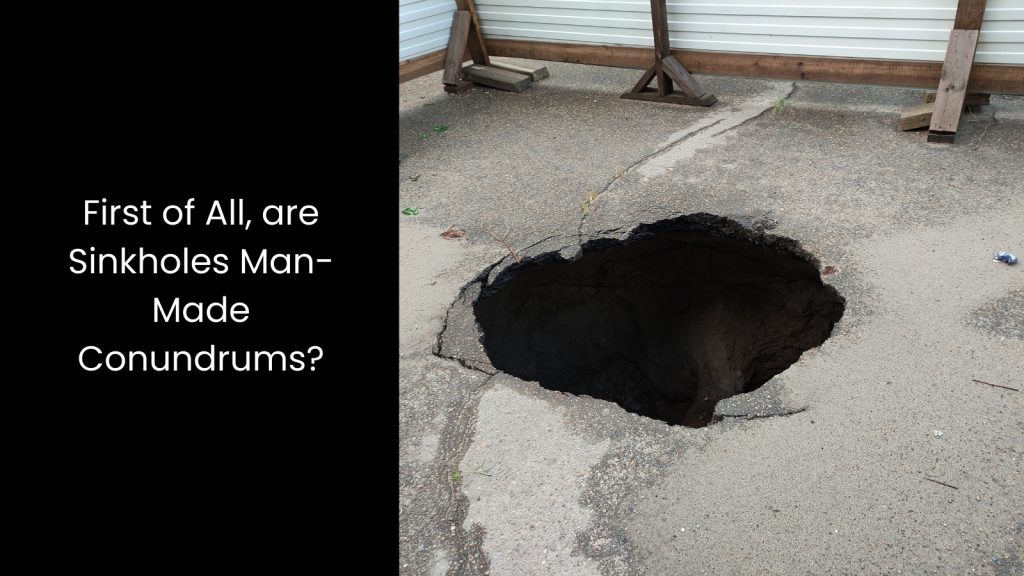
Each sinkhole hazard interacts with geological and anthropogenic factors, influencing the likelihood and severity of sinkhole formation in various regions. However, it is not always a man-made disaster; natural causes contribute to this disastrous formation. Here are some examples of Natural and man-made sinkhole hazards.
Natural Sinkhole Hazards
- Infiltration of Water into the Ground: All those natural processes that may directly lead to a weakening subsurface structure and, subsequently, create sinkholes.
- Lowering Water Table: The natural drop of the water table in which the support to the overlying ground will be reduced, tending to give rise to a sinkhole.
- Sinkholes of Dissolution: Suddenly appearing in the natural environment by the dissolution of soluble bedrock, like limestone, by groundwater.
- Subsidence of the Ground: Natural settling and subsidence of the ground due to geological processes constitute one factor contributing to the development of sinkholes.
- Thawing Frozen Ground: Natural thaws of permafrost or frozen ground that may result in eventual collapse and the formation of a sinkhole.
Vegetation Removal: Natural processes whereby vegetation removal rapidly advances erosion and contributes toward the formation of a sinkhole.
Man-made SInkhole Hazards
- Drilling: Man-made activities involving the drilling of oil, gas, or water that disturb the subsurface layers and lead to the emergence of sinkholes.
- Dynamic Loads: Artificial building and construction, heavy traffic, or infrastructure that strains the ground and helps initiate sinkholes.
- Excavation: Artificial excavation that perturbs the ground and leads to sinkholes.
- Foundation, Wall, and Floor Cracks: Man-made construction defects or structural inadequacies may lead to a local subsidence and sinkhole occurrence.
- Impoundment of Water: Artificial water impoundments can change hydrological conditions like induced sinkholes.
Solution Mining: Man-made extraction processes, such as salt mining, by dissolving minerals underground, which acts to weaken the ground and eventually leads to the appearance of a sinkhole.
Can A Smart Sinkhole System Save Lives?
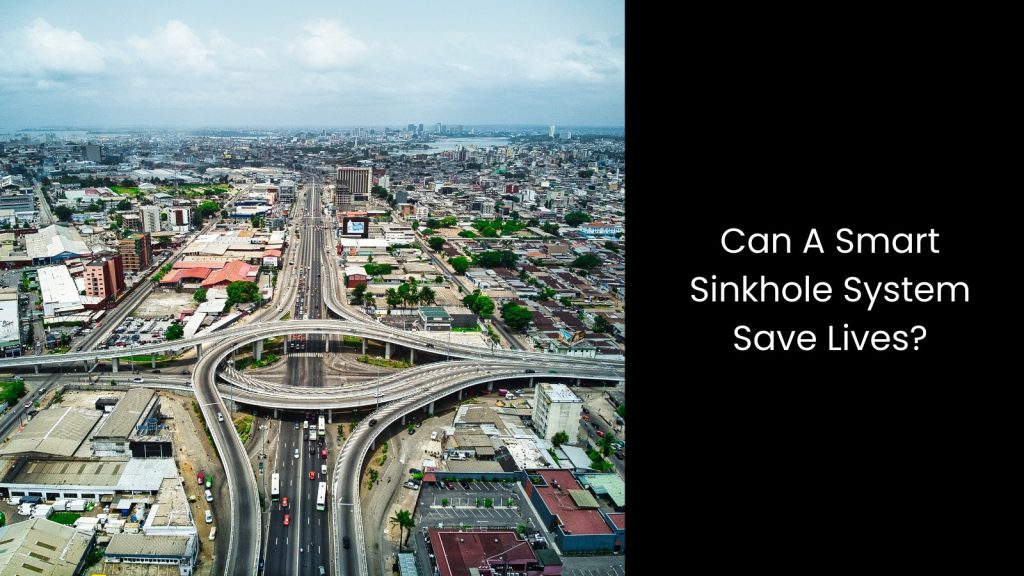
Intelligent sinkhole system optimisation will maximise safety in the public domain by offering Industry 4.0 technologies, such as advanced data analytics, IoT sensors, and machine learning algorithms, which predict and avert sinkhole events.
Therefore, it provides real-time monitoring of geological conditions and infrastructure integrity due to early detection of potential sinkhole formations. This means that cities can develop an extended monitoring system with integrated sensors and data analytics to identify risk factors related to soil erosion, variation in groundwater, and structural weaknesses. This proactive approach will allow timely interventions and inform urban planning and maintenance strategies for reducing the threat of accidents and saving lives. Adopting such innovative systems reflects a critical step forward in managing urban safety, joining the broader trend under the vision of Industry 4.0 for improved efficiency and safety in urban environments.
Recent Sinkhole Incidents
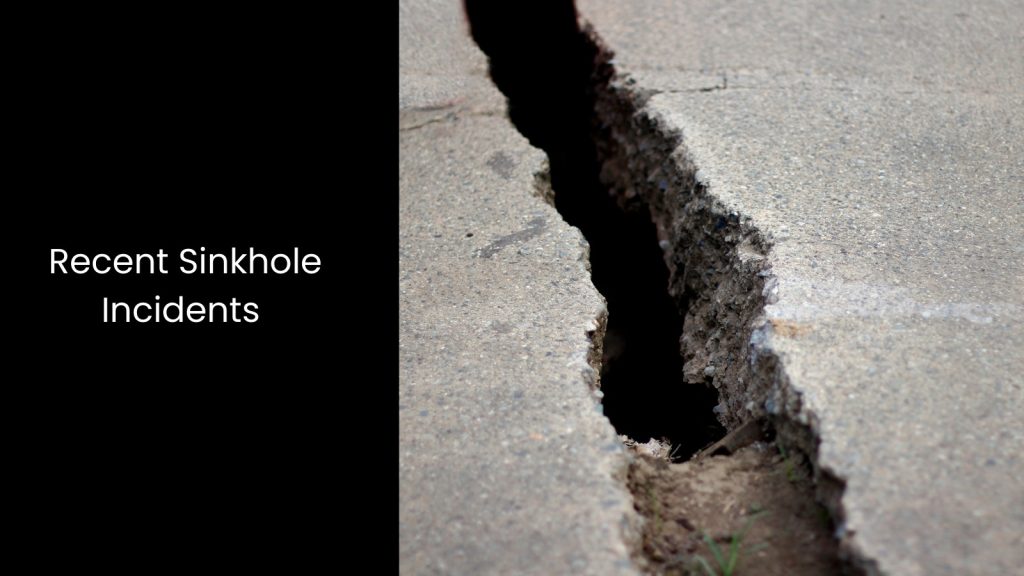
Here are some unfortunate sinkhole incidents that have reached the global lens.
2023
15 December, 2023 Sinkhole at North Yorkshire Town The dip, which appeared in Malton at the junction of Castlegate and Sheepfoot Hill, prompted an emergency response on Thursday evening. The sinkhole covered about half of the width of the carriageway, and firefighters, gas engineers and council workers were called to the scene after it appeared, Mr Duncan said. “The smell of gas is being investigated, but that is not at a level of concern. Access to homes and businesses is still possible,” he said. |
2024
June 9, 2024
Pipe Burst in SA Creates Massive Sinkhole
The Water and Sanitation Department investigated the cause of the sinkhole and worked around the clock until repairs were done, they added. Repairs to the affected road where the massive sinkhole has appeared will start over the coming days.
Not only an eyesore, but sinkholes can be hazardous as motorists and pedestrians can fall into one.
According to experts, they undermine the structural damage of the nearby buildings, and its foundation may have been compromised.
___________________________________________________________________________________________
August 23, 2024
The Extensive Search of Mrs Vijaya Lakshmi Gali
The Malaysian authorities switched the operation into recovery mode due to safety concerns after another sinkhole appeared nearby. The search was too dangerous to proceed, with rescuers fighting against water currents and debris in the sewer system. As of today, nothing was found of the Indian victim except for her pair of slippers.
___________________________________________________________________________________________
August 29, 2024
At least two people have been injured in Seoul after a car they were travelling in fell into a sinkhole which opened up in the middle of the road in the Seodaemun district in western Seoul on Thursday.
According to local media reports, a sinkhole appeared in the middle of the road in Seodaemun district, western Seoul.
The Korea Herald quoted: “The car with two people inside “rolled over sideways crashing into the sinkhole”.
Smart Sinkhole System Features That Mitigates Sinkhole-related Risks
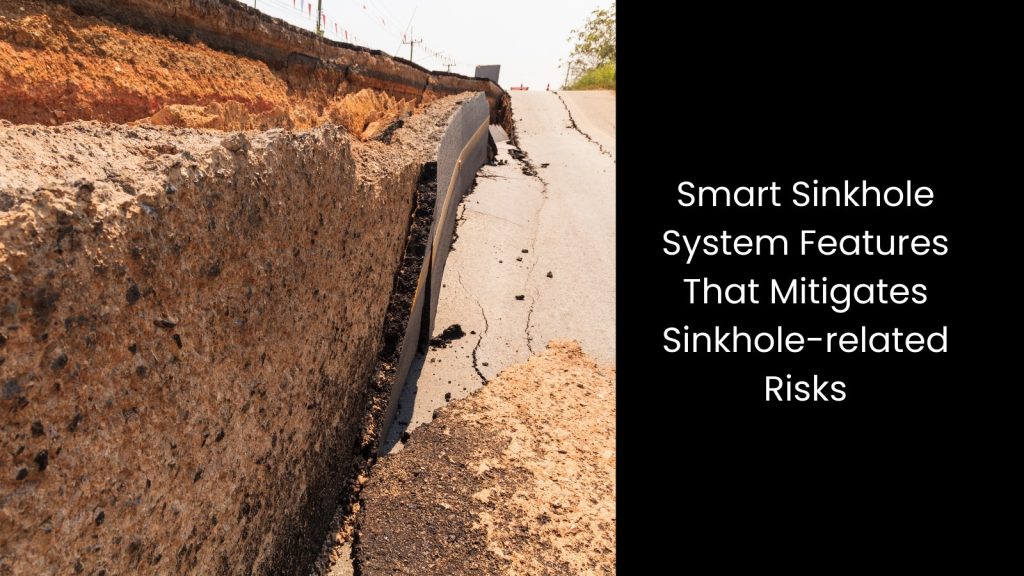
Here are some features a Smart Sinkhole Management System uses to detect sinkhole hazards with predictive assessments and smart informed decisions.
IoT, InSAR, and Fibre Optic Sensors for Sinkhole Detection
The intelligent monitoring and early warning of sinkholes with fibre optic sensors and InSAR technologies represent a milestone in geotechnical safety. These systems use fibre optic sensors capable of detecting minute changes in strain and vibration within the ground, thus delivering real-time data about subsurface conditions. These sensors detect the development of sinkholes in their early stage by monitoring environmental noise and structural integrity.
InSAR adds to this by detecting surface deformation that may reveal underlying geological instability. Together, they enable a coherent monitoring framework not only to understand the dynamics of sinkholes but also to help develop proactive measures to mitigate the risk associated with the formation of a sinkhole. Integration of such advanced sensing technologies will go a long way in reducing the socio-economic impacts of sinkholes by saving lives and infrastructure from sudden and mostly unpredictable failures.
IoT plays a significant role in the real-time monitoring and detection of sinkhole attacks. Sensors integrated within the network infrastructure can gather data relating to network traffic, the behaviour of nodes, and other relevant parameters. Further, this data can train AI models on anomaly detection and sinkhole identification.
AI and Machine Learning for Sinkhole Mitigation
The collected IoT data can be analysed using artificial intelligence and machine learning algorithms to notice malicious nodes or sinkhole attacks. Some techniques, such as deep learning, may also consider network traffic analysis to identify complex patterns and anomalies, permitting early detection and mitigation against sinkhole threats. AI and machine learning now show an increasing application in sinkhole mitigation, with new approaches to the problem of risk assessment and early detection.
The most common methods involve machine learning algorithms, such as the maximum entropy model, for producing sinkhole susceptibility maps. These are developed by considering different geological and hydrological factors, such as lithology, level of groundwater, and land use, that are critical in understanding the realisation of areas more susceptible to subsidence.
Other deep learning approaches have also been explored to extend, by a wide margin, the capability of sinkhole detection from satellite and drone images that enhance mapping accuracy. For instance, a study demonstrated the identification of sinkholes using thermal images with the 3D-Convolutional Neural Network, which showed very high precision and recall rates.
The development of machine learning can be integrated with InSAR data, thus enabling the observation of ground motions hence providing insight into subsurface conditions that may lead to sinkhole development. This advanced technological combination enhances the efficiency of sinkhole identification and facilitates timely interventions, ultimately reducing risks to life and property. Ongoing research outlines one perspective in which AI and machine learning can potentially enable essential changes in sinkhole risk management and urban planning.
Big Data Analytics for Proactive Mitigation
The enormous volumes of data emanating from sensors within IoT can be processed and analysed through big data analytics platforms. Applying predictive analytics and machine learning techniques to such data allows potential sinkhole vulnerabilities, prediction of future attacks, and proactive measures against risks in advance.
Through advanced data analysis and predictive modelling, Big Data Analytics empowers proactive mitigation of sinkholes. Big datasets integrated from varied sources such as geological surveys, satellite imagery, and historical occurrences of sinkholes enable advanced analytics to spot patterns and risk factors related to the formation of sinkholes. For example, machine learning algorithms, such as Maximum Entropy, have also been successfully applied to mapping sinkhole susceptibility in which the modelled results provide a map of those areas most likely to be subjected to sinkhole development according to factors such as lithology, levels of groundwater, and land use.
Consequently, the accuracy of sinkhole detection with deep learning methodologies, especially from convolutional neural networks, has also improved due to the automatic processing of satellite and drone images. These models allow the processing of vast volumes of visual information with much better identifications of sites likely to develop sinkholes. Further, it will enable the integration of InSAR technology for ground deformation monitoring; hence, real-time subsurface changes might precede a sinkhole.
In sum, Big Data Analytics has enabled early detection and risk assessment. It has informed urban planning and infrastructure maintenance and eventually contributed to effectively managing sinkhole hazards and protecting the community.
Blockchain for Secure Communication
With blockchain, smart city infrastructure can ensure secure communication, integrity, and authenticity of data. Using blockchain-based protocols, the nodes will verify the messages and restrict malicious nodes from injecting false information or launching sinkhole attacks.
The inherent properties of blockchain technology, such as decentralisation, encryption, and immutability, may unlock a very secure way of communication. Many of the following ways blockchain disrupts secure messaging:
- Decentralisation: Blockchain ensures messages cannot be hosted on one server by one entity but are distributed among computers in a network, which makes it very difficult for malicious actors to handle.
- Encryption from End to End: Most secure messaging applications using blockchain use strong encryption at their ends to ensure that only the intended recipient can decode the message. This implies that even the service provider cannot read the content of the messages. This contributes much to ensuring users’ privacy.
- Identity Verification: It provides blockchain-based security and transparency in identity verification. Hence, users can be sure they know who is on the other side of the channel. This reduces any threat of impersonation or phishing attacks.
- Immutable Records: By nature, blockchain is immutable; any message recorded on the blockchain cannot be changed or deleted. This aspect is of utmost importance for maintaining a memorable history of communication that might be needed for legality and regulation.
- Tokenisation and Micropayments: Some blockchain messaging applications also integrate cryptocurrency tokens for various purposes that are applied to incentivise participation in a network and deliver and send micropayments. This opens new possibilities for monetising communication and rewarding users for their contribution to network security.
The popular ones that have gained significant overall recognition include Status, Session, and Signal, each with features and advantages. While scalability challenges remain, along with limited user adoption and regulatory compliance, the potential for even more privacy and security drove innovation in blockchain-based messaging applications.
Additive Manufacturing for Rapid Deployment
This, in turn, would enable fast deployment and reconfiguration of the network infrastructure due to sinkhole attacks by additive manufacturing or 3D printing. Production of network components and devices will be possible with 3D printing, thus making rapid replacement of compromised nodes and swift restoration of network functionality possible.
Additive manufacturing, popularly referred to as 3D printing, holds the potential for rapid deployment into infrastructural management in dealing with sinkholes. This technology makes custom components and repair materials required for specific uses around sinkhole remediation much faster than is typical, facilitating quick responses against emergent threats due to sinkholes.
- Integration with Smart Technologies: Additive manufacturing can further improve strategies in sinkhole management, especially when combined with other smart technologies such as IoT and AI. Real-time data from sensors will inform the design, and the repair components meet the specific structural needs of the site. Predictive analytics can also determine where the installation of the AM solutions should be based on where the occurrences might be, enabling proactive reinforcement of the infrastructure.
- Material Efficiency and Waste Reduction: The geometrical complexities AM techniques can achieve involve only a little material waste. In sinkhole management, conventional manufacturing methods generate substantial waste material, contributing to environmental challenges. By reducing material usage, additive manufacturing reduces costs and promotes sustainability.
- Rapid Prototyping and Customisation: Additive manufacturing enables the rapid prototyping of repair solutions, often when every minute counts. Engineers can design and fabricate parts using digital models to fit precisely in the affected structure; promptly minimising rep repair time will go a long way in an urban area where a sinkhole disrupts critical services and may pose a significant safety risk.
How Can Tigernix Help in Detecting Sinkhole Hazards Beforehand

Large global metropolitan cities have significantly invested in constructing cutting-edge subterranean fluid transportation systems and securing utilities to offer seamless service levels and conserve public trust. However, sinkholes and the scarcity of drinking water are two main problems caused by leaks in subterranean pipe mains. The intricate issues that arise from the combination of seeping water and the earth, such as sinkholes, must be detected beforehand to secure lives, ecologies, and community trust while saving time, cost, and effort.
This is why Tigernix Asset Suites are enriched with Industry 4.0-embedded capabilities, helping detect sinkhole hazards via solutions specialising in utility infrastructure like water, wastewater, and road. Through their power for virtual prototyping, predictive analytics, and predictive maintenance, these robust solutions employ sensor and IoT capabilities to monitor ground conditions in real-time; they help early detect subsurface anomalies.
Water, Wastewater and Road Sinkhole Detection in One System?
Yes! Tigernix Asset Suites are highly integrable frameworks that allow municipalities and other organisations in charge of utility service to get a consolidated view of all asset health, performance, risk and cost trends under one screen. As the systems are empowered with AI, IoT, digital twin, simulation and many other innovative upgrades, the systems are trained to react during sinkhole hazards! Tigernix Smart and Integrated Asset Suites can significantly enhance the detection of sinkholes and mitigate their associated risks through several vital functionalities:
Enhanced Decision-Making Using Control Towers
Tigernix Control Tower System allows for more actionable insight into visualisation and reporting; these were quite helpful in stakeholder decision-making on asset management and maintenance strategies. For instance, if data reflects a higher chance of sinkholes in a specific area, management can prioritise inspections and allocate resources according to this analysis. These insights are action-ready solutions that summarise the situation to the end decision-makers of the utility service providers, such as directors, politicians, managers, and other senior personnel in water supply companies and city governments.
Predictive Analytics
Advanced analytics and machine learning algorithms adopted in the system make predictive maintenance strategies to predict potential water, wastewater and road infrastructure failures. By studying past trends and current conditions, our system points out the probability of the occurrence of a sinkhole given certain conditions, like geological conditions and the nature of the weather. This proactive approach thus allows necessary steps to be taken in the form of reinforcement or targeted inspections in high-risk areas.
Smart Real-time Data Monitoring Systems
Tigernix smart asset suites leverage the Internet of Things (IoT) to capture information in real-time through various sensors installed in the environment. Such sensors can monitor critical parameters such as soil moisture, vibration, and structural integrity. Through repeated analysis of this data, the Tigernix asset management system can identify anomalies that, if acted upon in time, may indicate the preliminary phase of the onset of sinkhole formation, in which the intervention will not result in unfortunate occurrences.
Integration and Collaboration
Tigernix Asset Systems facilitate better coordination and dissemination of information among various stakeholders involved in the process, such as engineers, maintenance teams, and contractors. This collaborative platform ensures that the parties involved are always abreast of the possible risks and can integrate their operations for appropriate mitigation. For example, if a monitoring system detects abnormal ground movement, immediate alerts can be availed to the concerned teams for immediate action.
Compliance and Safety Management
These industry 4.0 solutions will help organisations comply with safety regulations by automating processes of reporting and documentation associated with asset management. They will be involved in maintaining proper records of inspections and maintenance activities so that the companies remain in a legal position and limit their liability in case of any sinkhole incident.
InSAR Sinkhole Detection
Tigernix uses the latest InSAR-Interferometric Synthetic Aperture Radar-to revolutionise subsidence detection. This advanced satellite-mounted radar system will monitor the ground subsidence with millimeter-scale accuracy. The solution shall blend with complex algorithms indicating early sinkhole detection to minimise infrastructural risks and improve safety. Real-time alerts and predictive analytics empower decision-makers to proactively manage geohazards. This technology protects not only the communities and infrastructures that are important to it but also assists in resource management and drawing out contingency plans for such eventualities. By incorporating innovation into their business model, Tigernix stays ahead with InSAR Sinkhole Detection.
Employ Industry 4.0 Capabilities to Ensure Safer Sinkhole Hazard Control
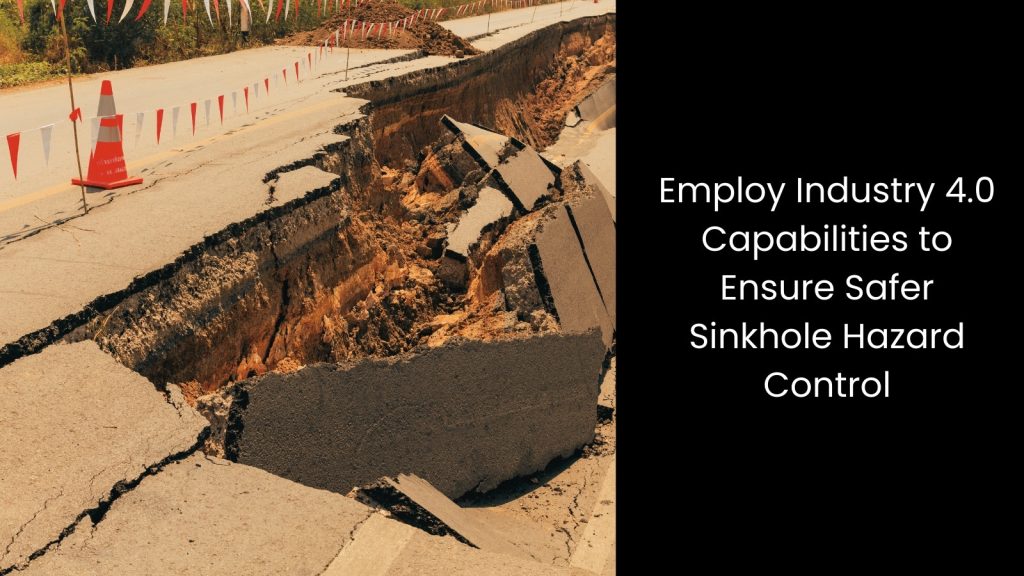
Integrating these Industry 4.0 technologies shall offer a comprehensive smart sinkhole detection and mitigation system with increased security and resilience for smart cities. The proposed system will implement IoT sensors, AI and machine learning algorithms, big data analytics, blockchain protocols, and additive manufacturing to detect, mitigate, and prevent real-time sinkhole attacks.







